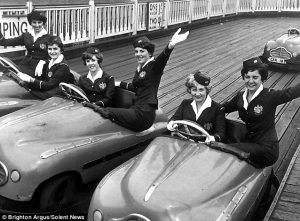The West Pier story closely follows the changing fortunes of the English seaside holiday. It began simply as a promenade pier where the Victorian middle classes could enjoy the thrill of walking on water without the hazards of becoming wet or sea sick. Somewhere they could ‘see and be seen’, take in the sea air and admire the panoramic views of the land.
 By the First World War it had evolved into a pleasure pier with a great variety of indoor and outdoor seaside entertainments. At the height of its popularity in the twenties, attractions ranged from paddle steamer excursions, daring high-divers and sea-bathing from the pier head to military bands, recitals in the Concert Hall by the pier’s resident orchestra and an all-year-round programme of plays, pantomimes and ballets in the Pavilion.
By the First World War it had evolved into a pleasure pier with a great variety of indoor and outdoor seaside entertainments. At the height of its popularity in the twenties, attractions ranged from paddle steamer excursions, daring high-divers and sea-bathing from the pier head to military bands, recitals in the Concert Hall by the pier’s resident orchestra and an all-year-round programme of plays, pantomimes and ballets in the Pavilion.
In its final stage after the Second World War it became a funfair pier. The Pavilion was converted to a restaurant on the top floor with the ‘Laughter Land’ games arcade in the theatre below. The Concert Hall became a tea room, and the delights of the Dodgems, Helter-skelter, and miniature racing car track could be enjoyed by all.
See more photographs of people on the pier during the 19th and 20th Century

